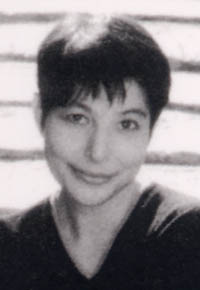Scansion
a system for describing the meter of a poem by identifying the number and the type(s) of feet per line. Following are the most common types of meter:
monometer one foot per line
dimeter two feet per line
trimeter three feet per line
tetrameter four feet per line
pentameter five feet per line
hexameter six feet per line
heptameter seven feet per line
octameter eight feet per line
Using these terms, then, a line consisting of five iambic feet is called “iambic pentameter,” while a line consisting of four anapestic feet is called “anapestic tetrameter.”
In order to determine the meter of a poem, the lines are “scanned,” or marked to indicate stressed and unstressed syllables which are then divided into feet. The following line has been scanned:
u / u / u / u / u /
And still she slept an az ure- lid ded sleep
The Conjuror
Patricia Beer
Arriving early at the cemetery
For 'the one o'clock, we looked around
At the last sparks of other people's grief,
The flowers fading back into the ground.
A card inscribed 'With reverent sympathy
From the Magicians' Club' was propped against
A top hat made of blossoms and a wand
Tied with a black velvet bow. We sensed
The rabbits and the ladies sawn in half
One blink away from being visible
Although the quick deceiving hand was changing
To flyaway dust under a ton of soil.
The funeral that we came for turned the corner.
They had been right to think the world of you,
Who conjured up for us, a hearse approaching,
An interest in life. Bravo. Bravo.
Patricia Beer’s poem “The Conjurer” is an example of scansion, a system for describing the meter of a poem by identifying the number and the types of feet per line. The first line sets up a clear pattern for the rest of the poem to follow. “This is a poem called ‘The Conjuror’ and it arose quite fortuitously as poems we all know so often do. We’d been to a funeral and we got there too early – it was one of those days you know when they come in every twenty minutes and we spent the time looking round the graveyard and saw something which I think would have appealed to anyone’s imagination – a conjuror’s grave” (Patricia Beer).

"To be idle is a short road to death and to be diligent is a way of life; foolish people are idle, wise people are diligent." ~Buddha
Patricia Beer

Patricia Beer (1924-1999) was born in Exmouth, Devon, into a Plymouth Brethren family, a childhood she recalls vividly in her autobiography Mrs Beer's House. Educated at Exmouth Grammar School, Exeter University and Oxford, she lived in Italy lecturing in English and later taught at Goldsmith's College. Her niece, the novelist Patricia Duncker, recalls the Beer of this period as being "glamorous, widely travelled and extremely well-read". Certainly the last two qualities are evident in her poetry though her culture and learning are worn lightly. She began her writing career in the 50s and was at first influenced by the poetics of the preceding decade, with is reliance on what she termed the "myth-kitty". However, she soon found a more modest tone suited her better and established the style that she largely adhered to for the rest of her life. Key subjects and recurring themes in her writing tend to the traditional - the workings of good and evil, God and religious belief, love, nature and the passing of time - but she brought to bear on these a wary and wry power of observation, what Duncker has called "her ruthless imagination". As well as her seven collections of poetry and autobiography she published a volume of literary criticism on Victorian fiction, Reader: I Married Him, and a novel set in 16th century Devon, Moon's Ottery. Following her marriage she moved back to the county of her birth and lived there until her death in 1999.
The two poems featured in the Archive are both about death, a subject she returned to constantly, in particular how the dead haunt the living. 'The Lost Woman' is an uncomfortable elegy for her mother which acknowledges the tendency to idealise the dead but also reveals a complex legacy of envy and insecurity. Unlike the placid, benign female muses of other poets, Beer's mother speaks to her in sharp tones, undermining her authority as a writer. This is a struggle about voice, about who is allowed to speak and what they can say, and as such it's instructive to hear the poem spoken aloud together with her revealing introduction. This time it's the dead mother who has the last word: "I am not lost". In style the poem is characteristic of Beer's informal-sounding but tightly controlled verse - the basic rhyme structure is ababcc but the effect is softened through half-rhyme and enjambment. 'The Conjuror' displays an equally unshowy technique, together with an element of sly de-bunking humour reminiscent of Stevie Smith whom Beer knew. The idea of a conjuror's grave is a strong one and Beer seizes on its implications with a spiky glee as she describes the ultimate vanishing trick.
(http://www.poetryarchive.org/poetryarchive/singlePoem.do?poemId=1535)
